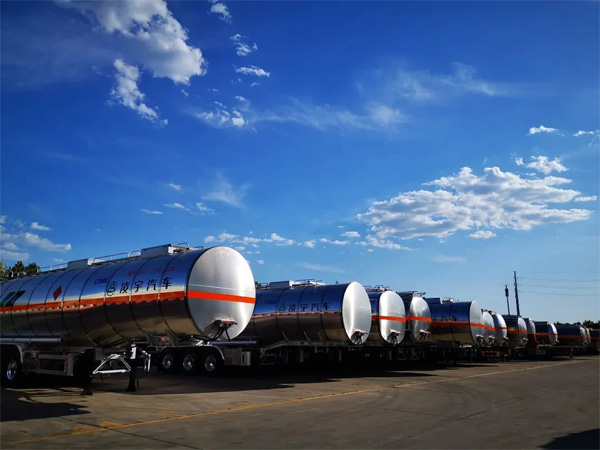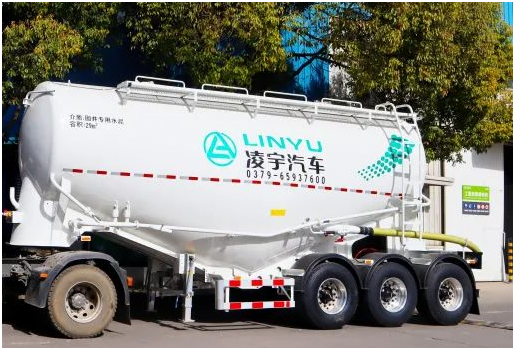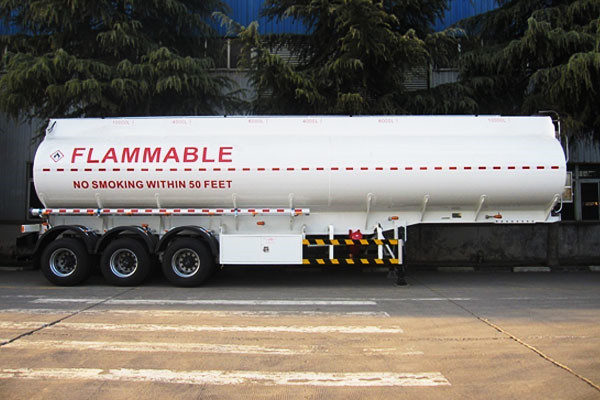The tank structure of the tank truck is an elliptical cylindrical or trapezoidal cylindrical body, made of high-quality steel plate. The whole tank body is divided into single or multiple warehouses. The warehouse can be divided into chambers. The lower end of the intermediate partition has a through hole. There are divided warehouses or multiple warehouses. The warehouses can be divided into compartments. There is a through hole at the lower end of the middle partition. The middle of each warehouse is welded with a partition reinforced wave partition to reduce the impact of the oil in the tank when the car is sucked and improve the rigidity of the tank.
We have introduced the process of loading and unloading oil on tank trucks before. In order to reduce the occurrence of tank truck loading and unloading accidents, we hereby give the following detailed descriptions of several precautions for tank truck loading and unloading operations:

(1) Reliable electrical connections and grounding should be made between the loading and unloading facilities of automobile tank trucks, including crane pipes, oil pipelines, and metal oil loading platforms.
(2) Ground scales, crane pipes, fuel guns, pipelines, etc. at the oil loading and unloading site should be bridged and equipped with electrostatic grounding devices. The grounding resistance is not more than 1002.
(3) The fuel delivery site of the automobile tanker should be equipped with a copper core soft stranded wire with a cross-sectional area of not less than 4mm2, one end of which is connected to a crocodile clamp that can break the paint, a special connecting clamp, etc., so as to be connected with the body of the tanker; The other end should be connected to a grounding device.
(4) Automobile tank trucks used to transport refined oil should use rubber towing belts, and metal towing belts are prohibited.
(5) A baffle should be installed in the oil tank of an automobile tanker. It is forbidden to use non-baffle tank trucks to transport easy fuel products.
(6) The resistance between the oil tank and the car body shall not be greater than 106Ω. The resistance value of the conductive path between any two points in the metal pipeline or on the conductive parts inside the oil tank and the end of the mopping tape shall not exceed 5Ω.
(7) When filling the tanker with oil, the maximum safe flow rate of crane pipes with different diameters should meet:
Oil filling method 80 90 100 110 120 150
Oil filling at the top (the numbers in parentheses are the corresponding flow m/s): 6.0 (110) 5.5 (125) 5.0 (140) 4.5 (155) 4.2 (170) 3.3 (210)
(8) The connection between the electrostatic grounding wire and the tank car should meet the following requirements.
① The connection should be tight and reliable, and winding connection is not allowed.
②Connect before opening the tank lid.
③It must be connected to the special ground terminal board of the tanker, etc., and not within 1.5m of the loading and unloading oil port.
④Remove the connection after closing the tank lid.
(9) During the operation, the loading and unloading of light oil should be carried out in strict accordance with the relevant operating procedures. It is strictly forbidden to conduct gauge, temperature measurement, sampling, or insert other objects into the tank after 2 minutes of unstable oil.
(10) When the tanker uses top-loading oil, the oil-loading crane pipe should go deep to the bottom of the tank, and the distance from the bottom of the tank should not be greater than 200mm. Splashing light oil is strictly prohibited.
(11) When replacing oil tanks with high volatility oil products (including tank cars) with low volatility oil products, the concentration of oil and gas in the tank should be detected. When the concentration of oil and gas exceeds 25% of the lower explosive limit, ventilation or cleaning should be carried out.
(12) In the process of loading and unloading flammable fuel products, no field test or test that may generate static ignition sparks is not allowed without approval.
(13) It is strictly forbidden to wipe and test vehicles, objects or the ground in the workplace, and conduct various temporary operations that may cause electrostatic hazards.

1. Operators should wear clothes and shoes that can discharge static electricity.
2. Use tools that do not produce sparks.
3. It is forbidden to work during thunderstorms.
4. Pay attention to prevent oil spills.
5. When oil spills or oil leaks are found, all oil filling operations at the oil filling point and adjacent oil filling positions should be stopped immediately. All valves that are open when unloading or loading oil from the bottom should be closed. Only key personnel should be left on the oil loading platform. Do not operate the starter of the vehicle until the spilled oil is cleaned up. The oil filling shall not be resumed until the person in charge of filling oil declares that the area is safe.
6. If a fire alarm occurs during oil loading and unloading, all operations should be stopped immediately, and unaffected vehicles should be driven away immediately. Close the oil tank valve to cut off the oil source, and immediately implement fire extinguishing operations.
7. Do not turn on the ignition switch for a long time after the car is stopped. A car once caught fire on its own in the garage. After investigation, it turned out that the ignition switch was still on after returning from the car last time. If it is turned on for a long time, it will not only cause the battery to discharge for a long time, but also cause the danger of fire.

8. It is not allowed to implement "self-flowing oil supply" for a long time. Sometimes due to the damage of the gasoline pump or the damage of the oil pipeline joints, the gasoline pump cannot normally supply fuel to the carburetor, and it cannot be repaired temporarily.
Only emergency treatment and self-flow fuel supply can be taken to drive the car back to the yard or drive to repair plant. At present, for the purpose of fire prevention, the road traffic management regulations formulated by the state do not allow this method to be used.
9. Open flame is not allowed to observe the height of the battery liquid level at night. When driving, the battery is in an overcharged state, and the excessive hydrogen accumulated in the shell causes an explosion when it encounters an open flame. Therefore, the small holes on the battery cover must be kept unblocked.
Living up to your trust! CIMC Vehicles' DTB/Concrete Mixer Truck Business Group successfully concludes its 2025 delivery schedule.
2025-12-26 09:38Twenty pure electric concrete mixer trucks delivered; authoritative media in Zhumadian witness the industry's low-carbon upgrade.
2025-12-18 16:43100 units delivered, 1000 units achieved! CIMC Vehicles' DTB mixer truck business group, together with FAW Jiefang and CATL, jointly support Xinxiang's new journey of green development
2025-12-12 14:00CIMC Vehicles and Shaanxi Heavy Truck jointly launched their New Energy 4.0 products, deepening the new ecosystem of intelligent integrated trailer-mounted vehicles
2025-12-12 11:30Address:Zhangheng Street corner Guanlin Road, Science and Technology Park, Luolong District, Luoyang City, Henan Province
E-mail:shiyk@lingyu.com
Phone:0086-379-65937678